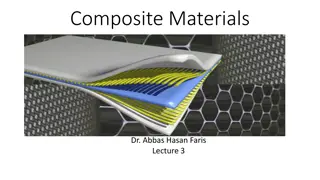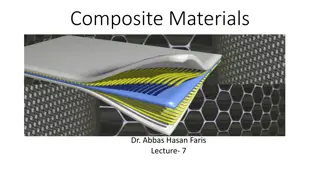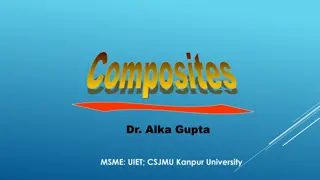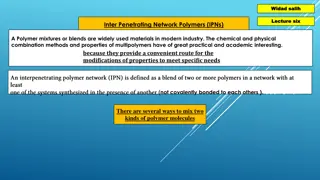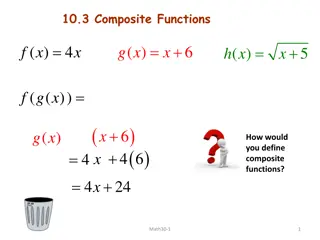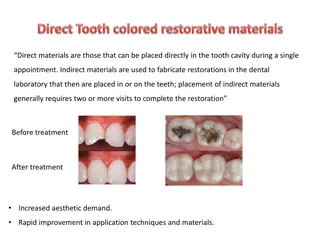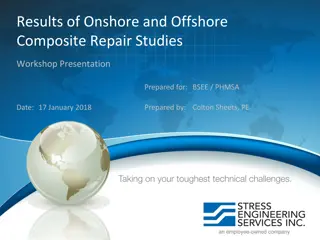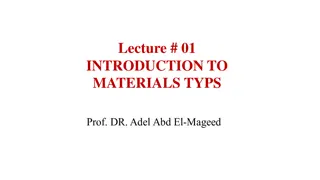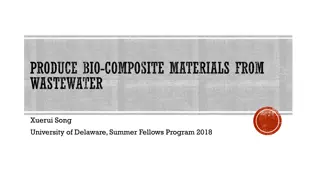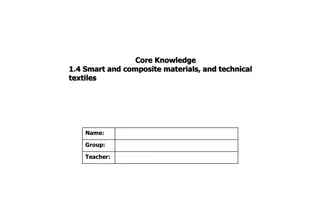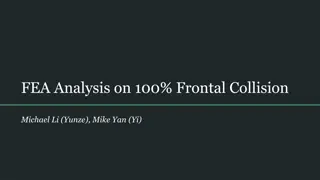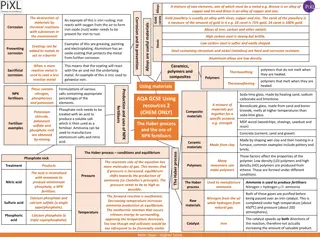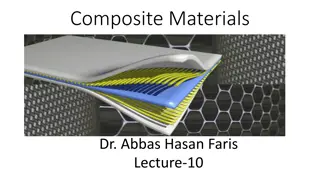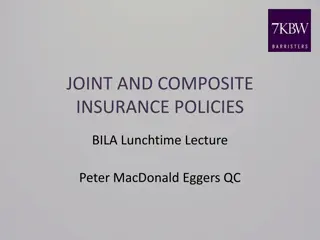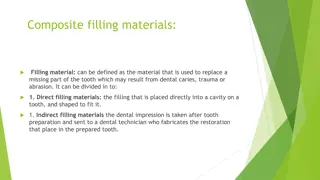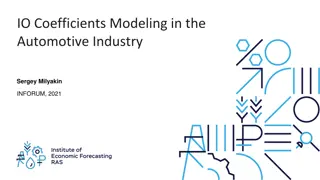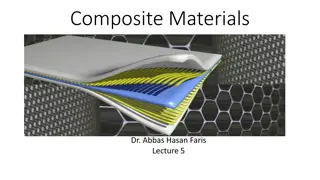Introduction to Composite Materials
Composite materials consist of two or more combined constituents at a macroscopic level, offering advantages over traditional metals such as improved strength, stiffness, and impact resistance. Advanced composites, like graphite/epoxy and boron/aluminum, find applications in aerospace and commercial industries. Aramids and coefficients of thermal expansion are discussed, highlighting the benefits of using composites over monolithic metals for various applications.
Download Presentation

Please find below an Image/Link to download the presentation.
The content on the website is provided AS IS for your information and personal use only. It may not be sold, licensed, or shared on other websites without obtaining consent from the author.If you encounter any issues during the download, it is possible that the publisher has removed the file from their server.
You are allowed to download the files provided on this website for personal or commercial use, subject to the condition that they are used lawfully. All files are the property of their respective owners.
The content on the website is provided AS IS for your information and personal use only. It may not be sold, licensed, or shared on other websites without obtaining consent from the author.
E N D
Presentation Transcript
1 INTRODUCTION TO COMPOSITE MATERIALS
2 A composite is a structural material that consists of two or more combined constituents that are combined at a macroscopic level and are not soluble in each other. One constituent is called the reinforcing phase and the one in which it is embedded is called the matrix . The reinforcing phase material may be in the form of fibers, particles, or flakes. The matrix phase materials are generally continuous. Examples of composite systems include concrete reinforced with steel and epoxy reinforced with graphite fibers, etc.
3 Advanced composites are composite materials that are traditionally used in the aerospace industries. These composites have high performance reinforcements of a thin diameter in a matrix material such as epoxy and aluminum. Examples are graphite/epoxy, Kevlar /epoxy, and boron/ aluminum composites. These materials have now found applications in commercial industries as well. Combining two or more materials together to make a composite is more work than just using traditional monolithic metals such as steel and aluminum.
4 -Aramids are aromatic compounds of carbon, hydrogen, oxygen, and nitrogen. -Coefficient of thermal expansion is the change in length per unit length of a material when heated through a unit temperature.
5 What are the advantages of using composites over metals? Monolithic metals and their alloys cannot always meet the demands of today s advanced technologies. Only by combining several materials can one meet the performance requirements. In many cases, using composites is more efficient. For example, in the highly competitive airline market, one is continuously looking for ways to lower the overall mass of the aircraft without decreasing the stiffness* and strength of its components.
6 This is possible by replacing conventional metal alloys with composite materials. Even if the composite material costs may be higher, the reduction in the number of parts in an assembly and the savings in fuel costs make them more profitable. Composites offer several other advantages over conventional materials. These may include improved strength, stiffness, fatigue and impact resistance, thermal conductivity, corrosion resistance ,etc.
7 -Stiffness is defined as the resistance of a material to deflection. - Strength is defined as the stress at which a material fails. - Fatigue resistance is the resistance to the lowering of mechanical properties such as strength and stiffness due to cyclic loading, such as due to take-off and landing of a plane, vibrating a plate, etc. -Impact resistance is the resistance to damage and to reduction in residual strength to impact loads, such as a bird hitting an airplane or a hammer falling on a car body.
8 -Thermal conductivity is the rate of heat flow across a unit area of a material in a unit time, when the temperature gradient is unity in the direction perpendicular to the area. -Corrosion resistance is the resistance to corrosion,
9 Composites Have Distinct Advantages Over Metals. Too, There Are Drawbacks Or Limitations In Using Them. Drawbacks And Limitations In Use Of Composites Include: High cost of fabrication of composites is a critical issue. For example, a part made of graphite/epoxy composite may cost up to 10 to 15 times the material costs. Mechanical characterization of a composite structure is more complex than that of a metal structure. Unlike metals, composite materials are not isotropic, that is, their properties are not the same in all directions.
10 Therefore, they require more material parameters. For example, a single layer of a graphite/epoxy composite requires nine stiffness and strength constants for conducting mechanical analysis. Repair of composites is not a simple process compared to that for metals. Sometimes critical flaws and cracks in composite structures may go undetected. Composites do not have a high combination of strength and fracture toughness compared to metals. Composites do not necessarily give higher performance in all the properties used for material selection.
11 The Main Reasons For Using Fibers Of Thin Diameter Are The Following: Actual strength of materials is several magnitudes lower than the theoretical strength. This difference is due to the inherent flaws in the material. Removing these flaws can increase the strength of the material. As the fibers become smaller in diameter, the chances of an inherent flaw in the material are reduced.
12 For higher ductility and toughness, and better transfer of loads from the matrix to fiber, composites require larger surface area of the fiber matrix interface. For the same volume fraction of fibers in a composite, the area of the fiber matrix interface is inversely proportional to the diameter of the fiber and is proved as follows. Fibers able to bend without breaking are required in manufacturing of composite materials, especially for woven fabric composites. Ability to bend increases with a decrease in the fiber diameter and is measured as flexibility.
13 Flexibility is defined as the inverse of bending stiffness and is proportional to the inverse of the product of the elastic modulus of the fiber and the fourth power of its diameter. Ductility is the ability of a material to deform without fracturing. It is measured by extending a rod until fracture and measuring the initial (Ai) and final (Af) cross-sectional area. Then ductility is defined as R = 1 (Af/Ai).
14 What Fiber Factors Contribute To The Mechanical Performance OfAComposite? Four Fiber Factors Contribute To The Mechanical Performance OfAComposite: Length: The fibers can be long or short. Long, continuous fibers are easy to orient and process, but short fibers cannot be controlled fully for proper orientation. Long fibers provide many benefits over short fibers. These include impact resistance, low shrinkage, improved surface finish, and dimensional stability. However, short fibers provide low cost, are easy to work with, and have fast cycle time fabrication procedures. Short fibers have fewer flaws and therefore have higher strength.
15 Orientation: Fibers oriented in one direction give very high stiffness and strength in that direction. If the fibers are oriented in more than one direction, such as in a mat, there will be high stiffness and strength in the directions of the fiber orientations. However, for the same volume of fibers per unit volume of the composite, it cannot match the stiffness and strength of unidirectional composites.
16 Shape: The most common shape of fibers is circular because handling and manufacturing them is easy. Hexagon and square shaped fibers are possible, but their advantages of strength and high packing factors do not outweigh the difficulty in handling and processing. Material: The material of the fiber directly influences the mechanical performance of a composite. Fibers are generally expected to have high elastic moduli and strengths. This expectation and cost have been key factors in the graphite, aramids, and glass dominating the fiber market for composites.
17 What are the matrix factors that contribute to the mechanical performance of composites? Use of fibers by themselves is limited, with the exceptions of ropes and cables. Therefore, fibers are used as reinforcement to matrices. The matrix functions include binding the fibers together, protecting fibers from the environment, shielding from damage due to handling, and distributing the load to fibers.
18 Although matrices by themselves generally have low mechanical properties compared to those of fibers, the matrix influences many mechanical properties of the composite. These properties include transverse modulus and strength, shear modulus and strength, compressive strength, interlaminar shear strength, thermal expansion coefficient, thermal resistance, and fatigue strength.
19 Other Than The Fiber And The Matrix, What Other Factors Influence The Mechanical Performance OfAComposite? Other factors include the fiber matrix interface. It determines how well the matrix transfers the load to the fibers. Chemical, mechanical, and reaction bonding may form the interface. In most cases, more than one type of bonding occurs.
20 Chemical bonding is formed between the fiber surface and the matrix. Some fibers bond naturally to the matrix and others do not. Coupling agents (Coupling agents are compounds applied to fiber surfaces to improve the bond between the fiber and matrix. For example, saline finish is applied to glass fibers to increase adhesion with epoxy matrix) are often added to form a chemical bond.
21 The natural roughness or etching of the fiber surface causing interlocking may form a mechanical bond between the fiber and matrix. If the thermal expansion coefficient of the matrix is higher than that of the fiber, and the manufacturing temperatures are higher than the operating temperatures, the matrix will radially shrink more than the fiber. This causes the matrix to compress around the fiber.
22 Reaction bonding occurs when atoms or molecules of the fiber and the matrix diffuse into each other at the interface. This interdiffusion often creates a distinct interfacial layer, called the interphase, with different properties from that of the fiber or the matrix. Although this thin interfacial layer helps to form a bond, it also forms microcracks in the fiber. These microcracks reduce the strength of the fiber and thus that of the composite.
23 Classification HowAre Composites Classified? Composites are classified by the geometry of the reinforcement particulate, flake, and fibers or by the type of matrix polymer, metal, ceramic, and carbon. Particulate composites consist of particles immersed in matrices such as alloys and ceramics. They are usually isotropic because the particles are added randomly. Particulate composites have advantages such as improved strength, increased operating temperature, oxidation resistance, etc. Typical examples include use of aluminum particles in rubber; silicon carbide particles in aluminum; and gravel, sand, and cement to make concrete.
24 Flake composites consist of flat reinforcements of matrices. Typical flake materials are glass, mica, aluminum, and silver. Flake composites provide advantages such as high out-of-plane flexural modulus, higher strength, and low cost. However, flakes cannot be oriented easily and only a limited number of materials are available for use.
25 Fiber composites consist of matrices reinforced by short (discontinuous) or long (continuous) fibers. Fibers are generally anisotropic and examples include carbon and aramids. Examples of matrices are resins such as epoxy, metals such as aluminum, and ceramics such as calcium alumino silicate. Continuous fiber composites are emphasized in this book and are further discussed in this chapter by the types of matrices: polymer, metal, ceramic, and carbon. The fundamental units of continuous fiber matrix composite are unidirectional or woven fiber laminas. Laminas are stacked on top of each other at various angles to form a multidirectional laminate.
26 Nanocomposites consist of materials that are of the scale of nanometers (10 9 m). The accepted range to be classified as a nanocomposite is that one of the constituents is less than 100 nm.
27 Polymer Matrix Composites What Are The Most Common Advanced Composites? The most common advanced composites are polymer matrix composites (PMCs) consisting of a polymer (e.g., epoxy, polyester, urethane) reinforced by thin diameter fibers (e.g., graphite, aramids, boron). For example, graphite/ epoxy composites are approximately five times stronger than steel on a weight for- weight basis. The reasons why they are the most common composites include their low cost, high strength, and simple manufacturing principles.
28 What Are The Drawbacks Of Polymer Matrix Composites? The main drawbacks of PMCs include low operating temperatures, high coefficients of thermal and moisture expansion,* and low elastic properties in certain directions. What Are The Typical Mechanical Properties Of Some Polymer Matrix Composites? Compare these properties with metals. Table blow gives typical mechanical properties of common polymer matrix composites.
30 Give names of various polymers used in advanced polymer composites. These polymers include epoxy, phenolics, acrylic, urethane, and polyamide. Why are there so many resin systems in advanced polymer composites? Each polymer has its advantages and drawbacks in its use: Polyesters: The advantages are low cost and the ability to be made translucent; drawbacks include service temperatures below 170 F (77 C), brittleness, and high Shrinkage in resins is found by measuring the density of the resin before and after cross-linking. If is the density before cross-linking and is the density after cross-linking. The percent shrinkage is defined as shrinkage = ( )/ 100) of as much as 8% during curing. shrinkage (*
31 Phenolics: The advantages are low cost and high mechanical strength; drawbacks include high void content. Epoxies: The advantages are high mechanical strength and good adherence to metals and glasses; drawbacks are high cost and difficulty in processing. Epoxy resins are the most commonly used resins. They are low molecular weight organic liquids containing epoxide groups. Epoxide has three members in its ring: one oxygen and two carbon atoms. The reaction of epichlorohydrin with phenols or aromatic amines makes most epoxies.
37 Give typical applications of polymer matrix composites. Applications of polymer matrix composites range from tennis racquets to the space shuttle. Rather than enumerating only the areas in which polymer based composites are used, a few examples have been taken from each industry. Emphasis has been placed on why a composite material is the material of choice.
38 Aircraft: The military aircraft industry has mainly led the use of polymer Composites Space: Two factors make composites the material of choice in space applications: high specific modulus and strength, and dimensional stability during large changes in temperature in space.
39 Sporting goods: Graphite/epoxy is replacing metals in golf club shafts mainly to decrease the weight and use the saved weight in the head. Medical devices: Applications here include the use of glass Kevlar/epoxy lightweight face masks for epileptic patients. Marine: The application of fiberglass in boats is well known. Hybrids of Kevlar glass/epoxy are now replacing fiberglass for improved weight savings, vibration damping, and impact resistance.
40 Automotive: The fiberglass body of the CorvetteR comes to mind when considering automotive applications of polymer matrix composites. Commercial: Fiber-reinforced polymers have many other commercial applications too. Examples include mops with pultruded fiberglass handles
41 Metal Matrix Composites What are metal matrix composites? Metal matrix composites (MMCs), as the name implies, have a metal matrix. Examples of matrices in such composites include aluminum, magnesium, and titanium. Typical fibers include carbon and silicon carbide. Metals are mainly reinforced to increase or decrease their properties to suit the needs of design. For example, the elastic stiffness and strength of metals can be increased, and large coefficients of thermal expansion and thermal and electric conductivities of metals can be reduced, by the addition of fibers such as silicon carbide.
42 What are the advantages of metal matrix composites? Metal matrix composites are mainly used to provide advantages over monolithic metals such as steel and aluminum. These advantages include higher specific strength and modulus by reinforcing low-density metals, such as aluminum and titanium; lower coefficients of thermal expansion by reinforcing with fibers with low coefficients of thermal expansion, such as graphite; and maintaining properties such as strength at high temperatures.
43 MMCs have several advantages over polymer matrix composites. These include higher elastic properties; higher service temperature; insensitivity to moisture; higher electric and thermal conductivities; and better wear, fatigue, and flaw resistances. The drawbacks of MMCs over PMCs include higher processing temperatures and higher densities.
44 Do any properties degrade when metals are reinforced with fibers? Yes, reinforcing metals with fibers may reduce ductility and fracture toughness. 26 Ductility of aluminum is 48% and it can decrease to below 10% with simple reinforcements of silicon carbide whiskers.
45 What are the typical mechanical properties of some metal matrix composites? Compare the properties with metals. Typical mechanical properties of MMCs are given in Table 1.
46 What are some of the applications of metal matrix composites? Metal matrix composites applications are Space: The space shuttle uses boron/aluminum tubes to support its fuselage frame. Military: Precision components of missile guidance systems demand dimensional stability that is, the geometries of the components cannot change during use. Transportation: Metal matrix composites are finding use now in automotive engines that are lighter than their metal counterparts
47 Ceramic Matrix Composites What are ceramic matrix composites? Ceramic matrix composites (CMCs) have a ceramic matrix such as alumina calcium alumino silicate reinforced by fibers such as carbon or silicon carbide. What are the advantages of ceramic matrix composites? Advantages of CMCs include high strength, hardness, high service temperature limits* for ceramics, chemical inertness, and low density. However, ceramics by themselves have low fracture toughness. Under tensile or impact loading, they fail catastrophically. Reinforcing ceramics with fibers, such as silicon carbide or carbon, increases their fracture toughness
48 What are the applications of ceramic matrix composites? Ceramic matrix composites are finding increased application in high-temperature areas in which metal and polymer matrix composites cannot be used. This is not to say that CMCs are not attractive otherwise, especially considering their high strength and modulus, and low density. Typical applications include cutting tool inserts in oxidizing and high-temperature environments.
49 Carbon Carbon Composites What are carbon carbon composites? Carbon carbon composites use carbon fibers in a carbon matrix. These composites are used in very high-temperature environments of up to 6000 F (3315 C), and are 20 times stronger and 30% lighter than graphite fibers.29
50 What are the advantages of carbon carbon composites? Carbon is brittle and flaw sensitive like ceramics. Reinforcement of a carbon matrix allows the composite to fail gradually and also gives advantages such as ability to withstand high temperatures, low creep at high temperatures, low density, good tensile and compressive strengths, high fatigue resistance, high thermal conductivity, and high coefficient of friction. Drawbacks include high cost, low shear strength, and susceptibility to oxidations at high temperatures.



